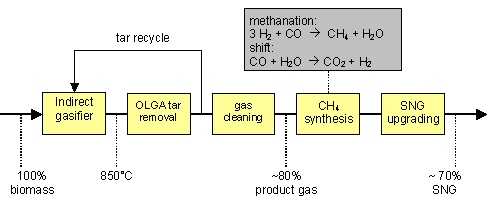SNG production technology
SNG is produced by converting the biomass via gasification into a methane-rich product gas and, after cleaning, conversion of the H2 and CO in the gas to CH4 by catalytic methanation. The crude SNG product has to be upgraded to pipeline specification by removal of CO2 and water. The general line-up of an integrated biomass gasification SNG system is shown in the figure below.
Methanation is a catalytic process that converts synthesis gas (mainly carbon monoxide and hydrogen) into methane with a nickel-based catalyst. Other gas components such as ethylene and BTX (benzene, toluene, and xylenes) can also be converted to methane depending on the type of catalyst. During the methanation process the main reactions are:
CO + 3 H2 => CH4 + H2O with reaction enthalpy of -206 kJ/mol
CO2 + 4 H2 => CH4 + 2 H2O with reaction enthalpy of -165 kJ/mol
From the heat of reaction given above it can be seen that the methanation process is strongly exothermic. Thus, part of the energy of these components is lost in the form of heat. Also, this heat has to be removed from the reactor efficiently.
The optimum system is based on an indirect gasifier operated at 7 to 20 bar, producing an essentially nitrogen-free product gas with already high initial CH4 concentration [1]. Typically, the gasifier is operated at 850°C. The product gas contains organic impurities (the so-called ‘tars’) and inorganic impurities like sulphur compounds and HCl. The tars are removed with the OLGA tar removal process and recycled to the gasifier for destruction into product gas components. Subsequently, the sulphur, chloride, and the other impurities are removed in the gas cleaning. In the catalytic synthesis the H2 and CO in the gas are converted into CH4. The crude SNG contains approximately three equal parts of CH4, CO2, and water. In the final gas upgrading, the CH4 and CO2 are removed and the product SNG is compressed to the pressure of the natural gas grid. The CO2 is not removed completely, as a few percent CO2 in the gas is required to meet the Wobbe index. The energy efficiency of SNG production from biomass is approximately 70%. In addition, 5 to 8% of net power can be produced from the heat generated in the process.
References:
A. van der Drift, C. M. van der Meijden and H. Boerrigter: MILENA gasification technology for high efficient SNG production from biomass. In the proceedings of the 14th European Biomass Conference & Exhibition, 17-21 October 2005, Paris, France.
